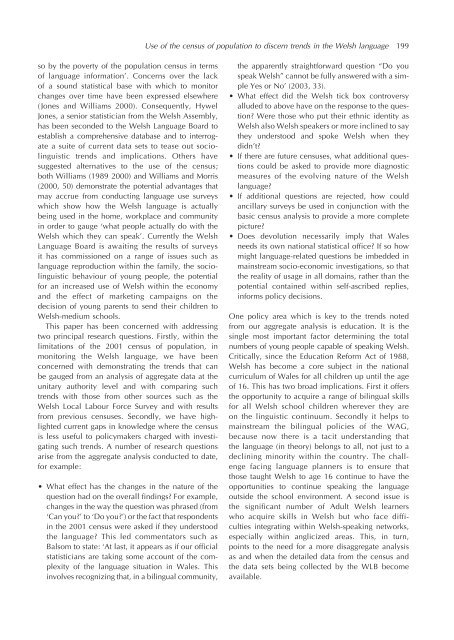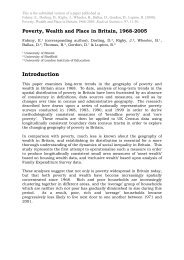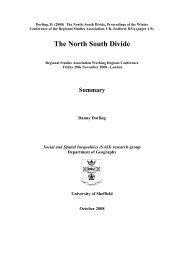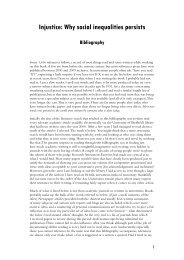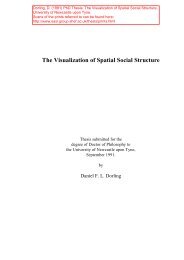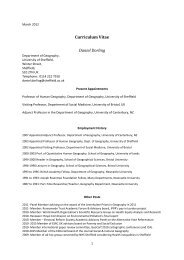Use of the census of population to discern trends in the Welsh ...
Use of the census of population to discern trends in the Welsh ...
Use of the census of population to discern trends in the Welsh ...
Create successful ePaper yourself
Turn your PDF publications into a flip-book with our unique Google optimized e-Paper software.
<strong>Use</strong> <strong>of</strong> <strong>the</strong> <strong>census</strong> <strong>of</strong> <strong>population</strong> <strong>to</strong> <strong>discern</strong> <strong>trends</strong> <strong>in</strong> <strong>the</strong> <strong>Welsh</strong> language 199so by <strong>the</strong> poverty <strong>of</strong> <strong>the</strong> <strong>population</strong> <strong>census</strong> <strong>in</strong> terms<strong>of</strong> language <strong>in</strong>formation’. Concerns over <strong>the</strong> lack<strong>of</strong> a sound statistical base with which <strong>to</strong> moni<strong>to</strong>rchanges over time have been expressed elsewhere(Jones and Williams 2000). Consequently, HywelJones, a senior statistician from <strong>the</strong> <strong>Welsh</strong> Assembly,has been seconded <strong>to</strong> <strong>the</strong> <strong>Welsh</strong> Language Board <strong>to</strong>establish a comprehensive database and <strong>to</strong> <strong>in</strong>terrogatea suite <strong>of</strong> current data sets <strong>to</strong> tease out sociol<strong>in</strong>guistic<strong>trends</strong> and implications. O<strong>the</strong>rs havesuggested alternatives <strong>to</strong> <strong>the</strong> use <strong>of</strong> <strong>the</strong> <strong>census</strong>;both Williams (1989 2000) and Williams and Morris(2000, 50) demonstrate <strong>the</strong> potential advantages thatmay accrue from conduct<strong>in</strong>g language use surveyswhich show how <strong>the</strong> <strong>Welsh</strong> language is actuallybe<strong>in</strong>g used <strong>in</strong> <strong>the</strong> home, workplace and community<strong>in</strong> order <strong>to</strong> gauge ‘what people actually do with <strong>the</strong><strong>Welsh</strong> which <strong>the</strong>y can speak’. Currently <strong>the</strong> <strong>Welsh</strong>Language Board is await<strong>in</strong>g <strong>the</strong> results <strong>of</strong> surveysit has commissioned on a range <strong>of</strong> issues such aslanguage reproduction with<strong>in</strong> <strong>the</strong> family, <strong>the</strong> sociol<strong>in</strong>guisticbehaviour <strong>of</strong> young people, <strong>the</strong> potentialfor an <strong>in</strong>creased use <strong>of</strong> <strong>Welsh</strong> with<strong>in</strong> <strong>the</strong> economyand <strong>the</strong> effect <strong>of</strong> market<strong>in</strong>g campaigns on <strong>the</strong>decision <strong>of</strong> young parents <strong>to</strong> send <strong>the</strong>ir children <strong>to</strong><strong>Welsh</strong>-medium schools.This paper has been concerned with address<strong>in</strong>gtwo pr<strong>in</strong>cipal research questions. Firstly, with<strong>in</strong> <strong>the</strong>limitations <strong>of</strong> <strong>the</strong> 2001 <strong>census</strong> <strong>of</strong> <strong>population</strong>, <strong>in</strong>moni<strong>to</strong>r<strong>in</strong>g <strong>the</strong> <strong>Welsh</strong> language, we have beenconcerned with demonstrat<strong>in</strong>g <strong>the</strong> <strong>trends</strong> that canbe gauged from an analysis <strong>of</strong> aggregate data at <strong>the</strong>unitary authority level and with compar<strong>in</strong>g such<strong>trends</strong> with those from o<strong>the</strong>r sources such as <strong>the</strong><strong>Welsh</strong> Local Labour Force Survey and with resultsfrom previous <strong>census</strong>es. Secondly, we have highlightedcurrent gaps <strong>in</strong> knowledge where <strong>the</strong> <strong>census</strong>is less useful <strong>to</strong> policymakers charged with <strong>in</strong>vestigat<strong>in</strong>gsuch <strong>trends</strong>. A number <strong>of</strong> research questionsarise from <strong>the</strong> aggregate analysis conducted <strong>to</strong> date,for example:• What effect has <strong>the</strong> changes <strong>in</strong> <strong>the</strong> nature <strong>of</strong> <strong>the</strong>question had on <strong>the</strong> overall f<strong>in</strong>d<strong>in</strong>gs? For example,changes <strong>in</strong> <strong>the</strong> way <strong>the</strong> question was phrased (from‘Can you?’ <strong>to</strong> ‘Do you?’) or <strong>the</strong> fact that respondents<strong>in</strong> <strong>the</strong> 2001 <strong>census</strong> were asked if <strong>the</strong>y unders<strong>to</strong>od<strong>the</strong> language? This led commenta<strong>to</strong>rs such asBalsom <strong>to</strong> state: ‘At last, it appears as if our <strong>of</strong>ficialstatisticians are tak<strong>in</strong>g some account <strong>of</strong> <strong>the</strong> complexity<strong>of</strong> <strong>the</strong> language situation <strong>in</strong> Wales. This<strong>in</strong>volves recogniz<strong>in</strong>g that, <strong>in</strong> a bil<strong>in</strong>gual community,<strong>the</strong> apparently straightforward question “Do youspeak <strong>Welsh</strong>” cannot be fully answered with a simpleYes or No’ (2003, 33).• What effect did <strong>the</strong> <strong>Welsh</strong> tick box controversyalluded <strong>to</strong> above have on <strong>the</strong> response <strong>to</strong> <strong>the</strong> question?Were those who put <strong>the</strong>ir ethnic identity as<strong>Welsh</strong> also <strong>Welsh</strong> speakers or more <strong>in</strong>cl<strong>in</strong>ed <strong>to</strong> say<strong>the</strong>y unders<strong>to</strong>od and spoke <strong>Welsh</strong> when <strong>the</strong>ydidn’t?• If <strong>the</strong>re are future <strong>census</strong>es, what additional questionscould be asked <strong>to</strong> provide more diagnosticmeasures <strong>of</strong> <strong>the</strong> evolv<strong>in</strong>g nature <strong>of</strong> <strong>the</strong> <strong>Welsh</strong>language?• If additional questions are rejected, how couldancillary surveys be used <strong>in</strong> conjunction with <strong>the</strong>basic <strong>census</strong> analysis <strong>to</strong> provide a more completepicture?• Does devolution necessarily imply that Walesneeds its own national statistical <strong>of</strong>fice? If so howmight language-related questions be imbedded <strong>in</strong>ma<strong>in</strong>stream socio-economic <strong>in</strong>vestigations, so that<strong>the</strong> reality <strong>of</strong> usage <strong>in</strong> all doma<strong>in</strong>s, ra<strong>the</strong>r than <strong>the</strong>potential conta<strong>in</strong>ed with<strong>in</strong> self-ascribed replies,<strong>in</strong>forms policy decisions.One policy area which is key <strong>to</strong> <strong>the</strong> <strong>trends</strong> notedfrom our aggregate analysis is education. It is <strong>the</strong>s<strong>in</strong>gle most important fac<strong>to</strong>r determ<strong>in</strong><strong>in</strong>g <strong>the</strong> <strong>to</strong>talnumbers <strong>of</strong> young people capable <strong>of</strong> speak<strong>in</strong>g <strong>Welsh</strong>.Critically, s<strong>in</strong>ce <strong>the</strong> Education Reform Act <strong>of</strong> 1988,<strong>Welsh</strong> has become a core subject <strong>in</strong> <strong>the</strong> nationalcurriculum <strong>of</strong> Wales for all children up until <strong>the</strong> age<strong>of</strong> 16. This has two broad implications. First it <strong>of</strong>fers<strong>the</strong> opportunity <strong>to</strong> acquire a range <strong>of</strong> bil<strong>in</strong>gual skillsfor all <strong>Welsh</strong> school children wherever <strong>the</strong>y areon <strong>the</strong> l<strong>in</strong>guistic cont<strong>in</strong>uum. Secondly it helps <strong>to</strong>ma<strong>in</strong>stream <strong>the</strong> bil<strong>in</strong>gual policies <strong>of</strong> <strong>the</strong> WAG,because now <strong>the</strong>re is a tacit understand<strong>in</strong>g that<strong>the</strong> language (<strong>in</strong> <strong>the</strong>ory) belongs <strong>to</strong> all, not just <strong>to</strong> adecl<strong>in</strong><strong>in</strong>g m<strong>in</strong>ority with<strong>in</strong> <strong>the</strong> country. The challengefac<strong>in</strong>g language planners is <strong>to</strong> ensure thatthose taught <strong>Welsh</strong> <strong>to</strong> age 16 cont<strong>in</strong>ue <strong>to</strong> have <strong>the</strong>opportunities <strong>to</strong> cont<strong>in</strong>ue speak<strong>in</strong>g <strong>the</strong> languageoutside <strong>the</strong> school environment. A second issue is<strong>the</strong> significant number <strong>of</strong> Adult <strong>Welsh</strong> learnerswho acquire skills <strong>in</strong> <strong>Welsh</strong> but who face difficulties<strong>in</strong>tegrat<strong>in</strong>g with<strong>in</strong> <strong>Welsh</strong>-speak<strong>in</strong>g networks,especially with<strong>in</strong> anglicized areas. This, <strong>in</strong> turn,po<strong>in</strong>ts <strong>to</strong> <strong>the</strong> need for a more disaggregate analysisas and when <strong>the</strong> detailed data from <strong>the</strong> <strong>census</strong> and<strong>the</strong> data sets be<strong>in</strong>g collected by <strong>the</strong> WLB becomeavailable.


